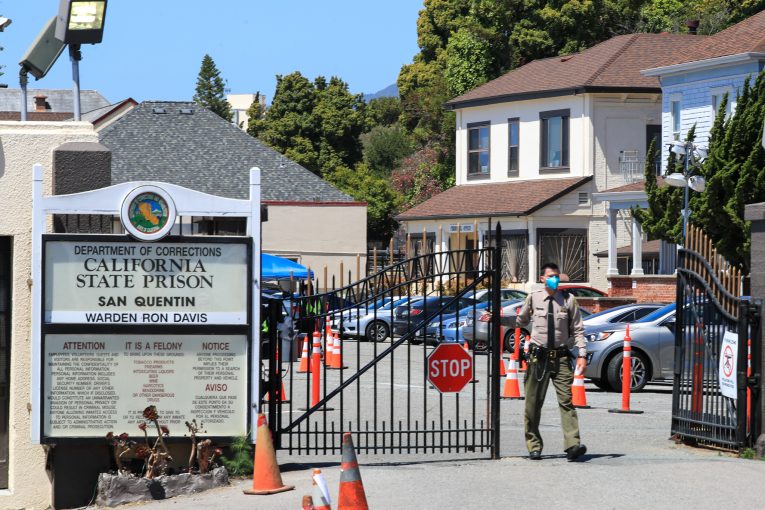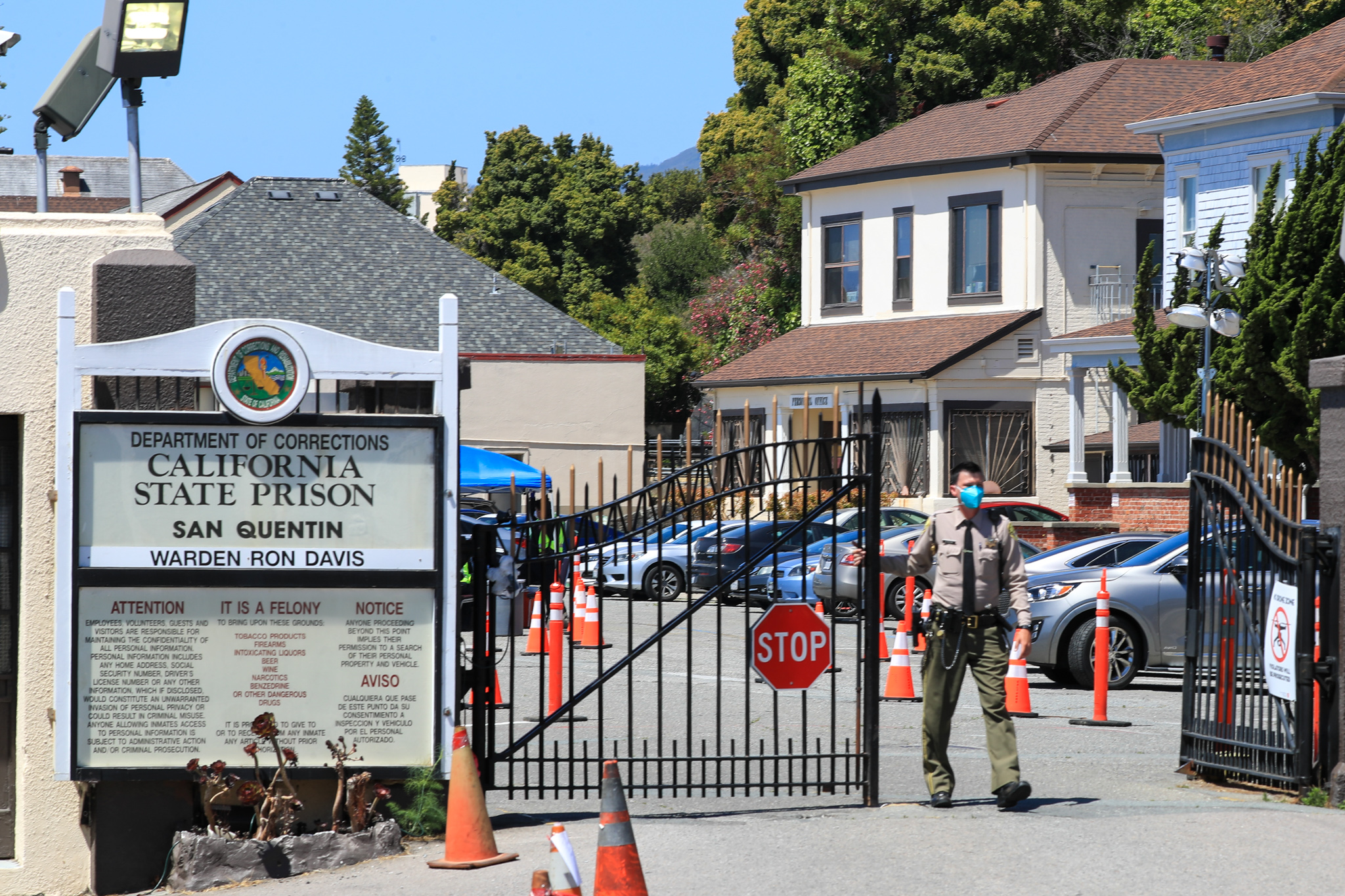

By Bella Mettag
SAN FRANCISCO – As COVID-19 cases and death tolls continue to rise within state correctional facilities, the call for widespread release has grown—Friday, Gov. Newsom announced the release of up to 8,000 by August from state prisons, which report 5,841 cases among inmates and 1,222 among staff.
That was after it was announced that more than a third of inmates and staff at San Quentin State Prison tested positive for the coronavirus.
Two federal judges, Kimberly J. Mueller of Sacramento and Jon S. Tigar of Oakland, are hoping to create a panel of judges that can order the release of prisoners. After visiting several prisons, Tigar has asked the state to begin releases as well, especially of medically vulnerable groups.
In a hearing last Thursday, Tigar called the conditions “gravely concerning,” saying that “people at [California Medical Facility] are living on top of each other.” Tigar has also urged Governor Newsom specifically to visit the prisons himself.
Newsom is also feeling pressure from prison activists, politicians, the Bay Area medical community, and other Bay Area citizens.
In a 50-strong gathering in front of San Quentin’s gates this Thursday, activists like James King, a former San Quentin incarcerated person, spoke up and shared stories of what is happening in San Quentin now. King read a letter from Thang Tran, a current SQ resident, that said: “We’re dying in here.”
State senator Scott Weiner (D- San Francisco) also attended, along with four other assemblymembers, public defenders, medical experts, and other community members.
Doctors like Peter Chin-Hong, an infectious disease expert and physician at UCSF, are supportive of releases, citing not only the danger to the prison population but also the stress outbreaks have  put on Bay Area medical facilities
put on Bay Area medical facilities
Effect of CDCR Outbreaks on Public
Continuing CDCR outbreaks are putting a strain on California healthcare services and firefighting forces.
In counties with large prison outbreaks, hospitals are seeing an influx of cases. In Marin County, 12 of the 31 cases in hospitals are from San Quentin. Most of those cases are evenly split between two small, local hospitals—Marin General Hospital, just four miles away from SQ, and Kaiser Permanente San Rafael Medical Center.
While the hospitals are not at capacity, patients who are incarcerated are creating other issues. According to Dr. Mark Willis, Marin County Health director, it is harder to find beds for inmates because they need to have a correctional officer with them at all times.
Correctional officers are also adding to the shortage of personal protective equipment—while CDCR provides N-95 masks to officers while they are at the prison, the hospitals have to provide full protective gear at the hospitals. Currently, hospital staff are reusing N95 masks because of short supply.
On Monday, Governor Newsom said that some other Bay Area hospitals, like St. Francis Hospital in San Francisco and Seton Medical Center in San Mateo, are working to take some burden off of hospitals local to San Quentin.
CDCR outbreaks are also hindering the firefighting industry during its most important season.
After an initial outbreak of four cases at California Correctional Center on June 21, 12 Northern California Conservation centers were put in quarantine.
These centers supply Cal Fire with more than a thousand firefighting inmates, whom Cal Fire relies upon for a lot of frontline work during wildfires, like building fire breaks and putting out embers. The quarantine has meant that only 94 out of the total 192 firefighting crews are available.
In order to make up for the loss, Newsom announced the hiring of 858 seasonal firefighters and 172 full-time employees to the California Department of Forestry and Fire Protection.
CDCR Confirmed Cases and Outcomes
As of July 10, there are a total of 5,814 confirmed COVID-19 cases in the CDCR facilities, with 31 deaths—nine in just the past week. CA State Prison Corcoran (COR), which has 581 confirmed cases, has had its first death.
Twenty-eight percent of the total positive cases are from San Quentin. Cases at California Rehabilitation Center (CRC) in Norco have more than doubled in the past week, currently standing at 252.
Three CDCR facilities, California Health Care Facility (CHCF), Folsom State Prison (FSP) and CA Medical Facility (CMF), have reported their first case of COVID-19. Nine CDCR facilities, including the Central California Women’s Facility, are still yet to report any.
COVID-19 in CDCR’s San Quentin
Since last week, there have been four more deaths in San Quentin, now totaling seven. Although there has been no official confirmation yet, they are suspected to be COVID-19 related.
One of them includes David Reed, 60, who was on San Quentin’s death row. According to officials, he died Tuesday at an outside hospital from what appeared to be complications related to the coronavirus. Reed was sentenced to death for the 2004 murder of Ricky Mosley, a black transient man, in Southern California.
According to news reports at the time, the jury found that the murder was a hate crime, as Reed used a racial epithet to describe the 34-year-old victim in an interview. He also told investigators that he doesn’t like Black people and had the words “white pride” tattooed on his body.
Reed’s death was the latest from SQ, which currently leads with 1,664 confirmed cases.
To treat the growing outbreak, SQ has assembled multiple tents, as well as converting a warehouse, for infected staff and inmates. Each tent can house up to 10 patients, while the warehouse will turn into a 220-bed care site.
Nursing staff from the California Correctional Health Care Service have also been reassigned to assist in health care operations at SQ from other facilities.
In a tweet, Senator Scott Wiener wrote, “It’s unacceptable & people are getting sick & dying. San Quentin’s prison population needs to be reduced ASAP. No one should be transferred w/o being tested. No more transfers to ICE.”
During the past four months, SQ declined free coronavirus tests and advice on protecting prisons from the pandemic. Law firms filed motions requesting California Governor Newsom to compel California’s prisons to follow expert advice, such as frequently testing and releasing inmates.
The federal court denied the motions, and correctional facilities did not implement these recommended measures. As a result, the outbreak has spread astronomically, catching the attention of lawmakers.
Staff at the San Francisco Public Defender’s office have also worked to secure the immediate release of roughly 60 clients in SQ.
“The only way we can protect the lives of people at San Quentin and the larger public is to reduce the prison population as quickly as possible,” San Francisco Public Defender Manohar Raju said in a statement. “Not only is the treatment of incarcerated people inside California’s prisons unconscionable, but so is the lack of information and transparency regarding the outbreak.”
Ralph Diaz, Newsom’s corrections secretary, said that prison officials will “aim to implement these decompression measures in a way that aligns both public health and public safety.”
CDCR Comparisons – California and the US
According to the Marshall Project, as of July 10, California prisons are third in the country in number of confirmed cases, following Texas and Federal prisons. California’s deaths make up 4.7% of the total US deaths in prisons.
There have been 1,222 confirmed cases of COVID-19 in CDCR staff, an increase of 44% from last week. 719 are active, and 2 staff members have died from complications related to the coronavirus.
CDCR and CCHCS Precautions
On July 6, CCHCS put out a memorandum announcing some changes in leadership that were made in order to “meet current response needs.”
On June 7, CDCR announced that an old furniture warehouse will be renovated to accommodate 220 individuals for medical care and better distancing. This will start being filled this coming Wednesday.
On June 8, it was mandated that all prison staff must wear N-95 masks while on institution grounds. Three CDCR facilities (California State Prison-Los Angeles County,, California State Prison-Sacramento, and Folsom State Prison) began mandatory staff testing.
On June 9, CDCR secretary Ralph Diaz implemented the Positive Programming Credit program, which allows inmates who did not commit a serious Rules Violation between May 1 and July 5 to receive 12 weeks of credit. The credit they receive will be removed from their sentence. Those who have a death sentence or life without parole are not eligible. According to the CDCR, the program could benefit up to 108,000 people and allow for around 3,100 to be released soon,
On June 10, Newsom announced the staggering release of approximately 8,000 inmates between now and August.
All inmates with 180 days or less to serve are eligible for release, except those who are sex offenders or are in on domestic abuse or violent charges. Those over 30 years of age will be immediately eligible, and those who are under will be reviewed case-by-case.
In eight of the largest facilities (San Quentin State Prison , Central California Women’s Facility, California Health Care Facility, California Institution for Men, California Institution for Women, California Medical Facility, Folsom State Prison and Richard J. Donovan Correctional Facility), those with a year or less to serve could also be eligible for release.
Those who are deemed “high risk” for COVID by CCHCS are also eligible for release. These will be reviewed case-by-case.
Inmates will be tested within seven days for release, and victims will be notified as per CDCR guidelines.
To sign up for our new newsletter – Everyday Injustice – https://tinyurl.com/yyultcf9
